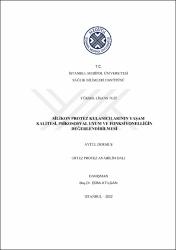| dc.contributor.advisor | Atılgan, Esra | |
| dc.contributor.author | Durmuş, Aytül | |
| dc.date.accessioned | 2023-12-20T08:41:00Z | |
| dc.date.available | 2023-12-20T08:41:00Z | |
| dc.date.issued | 2022 | en_US |
| dc.date.submitted | 2022-06-28 | |
| dc.identifier.citation | Durmuş, A. (2022). Silikon protez kulanıcılarının yaşam kalitesi, psikososyal uyum ve fonksiyonelliğin değerlendirilmesi. (Yayımlanmamış yüksek lisans tezi). İstanbul Medipol Üniversitesi Sağlık Bilimleri Enstitüsü, İstanbul. | en_US |
| dc.identifier.uri | https://tez.yok.gov.tr/UlusalTezMerkezi/tezSorguSonucYeni.jsp | |
| dc.identifier.uri | https://hdl.handle.net/20.500.12511/12044 | |
| dc.description.abstract | Parsiyel el ve ayak amputasyonu olan bireyler çeşitli aktivite kısıtlamalarına, mobilite sorunlarına, fonksiyonel yaşamda eksikliklere ve estetik kaygı ile birlikte yaşamlarında ciddi psikolojik zorluklara yol açmaktadır. Bu psikolojik sıkıntılar zamanla bireylerde sosyal yaşama uyum sağlamada sorunlara sebep olmaktadır. Parsiyel amputasyon geçiren kişilere silikon protez önerilmektedir. Bu sebeple parsiyel amputasyon geçiren kişilere uygulanacak olan protezler, ampute bireylerin hayatlarının kolaylaşmasında büyük bir öneme sahiptir. Bu çalışma, parsiyel el ve ayak amputasyonu geçiren ve silikon el veya ayak protezi kullanan kişilerin yaşam kalitesi, psikososyal uyumunu ve fonksiyonelliğini değerlendirmek amacıyla yapıldı. Çalışmaya parsiyel el-ayak veya parmak amputasyonu geçiren 32 kişi dahil edildi. Silikon el veya parmak protezi kullanan 13 birey (Grup 1) ve silikon ayak veya parmak protezi kullanan 19 birey (Grup 2) olmak üzere iki gruba ayrıldı. Değerlendirmeler; ağrı için seviyesi Görsel Analog Skala (GAS), fonksiyonel kapasite için Trinity Amputasyon ve Protez Deneyimleri Ölçekleri (TAPES), yaşam kalitesi için Notthingham Sağlık Profili (NSP) anketleri ile yapıldı. Çalışmadan elde edilen veriler SPSS programı kullanılarak analiz edildi. Elde edilen sonuçlara göre, TAPES açısından değerlendirildiğinde Grup 1 katılımcılarının Grup 2'ye göre fonksiyonel kısıtlama alt ölçeklerinde anlamlı farkları olduğu görüldü (p<0,05). NSP'nin bütün alt ölçeklerinde ise ikinci grup birinci gruba kıyasla anlamlı fark olduğu görüldü. Çalışmada, katılımcıların silikon protez kullanımının her iki grubu da olumlu etkilediği bulundu. Silikon el veya parmak protezi kullanan bireylerin, silikon ayak veya parmak protezi kullanan bireylere göre psikososyal uyum, yaşam kalitesi ve fonksiyonelliklerinin daha iyi olduğu bulundu. Bu durumun elin görselliğinin fazla olması ve bireylerde tam bir benlik imajı oluşturmasından dolayı ortaya çıktığını savunmaktayız. | en_US |
| dc.description.abstract | Individuals with partial hand and foot amputation cause various activity restrictions, mobility problems, deficiencies in functional life, and serious psychological difficulties in their lives with aesthetic anxiety. These psychological problems cause problems in adapting to social life in individuals over time. Silicone prosthesis is recommended for people who have had partial amputation. For this reason, prostheses to be applied to people who have undergone partial amputation have a great importance in facilitating the lives of amputees. This study was conducted to evaluate the quality of life, psychosocial adjustment and functionality of people who had partial hand and foot amputation and used silicone hand or foot prosthesis. Thirty-two people who had partial hand-foot or finger amputation were included in the study. 13 individuals using silicone hand or finger prostheses (Group 1) and 19 individuals using silicone foot or finger prostheses (Group 2) were divided into two groups. Evaluations; level for pain was measured with the Visual Analog Scale (GAS), for functional capacity, the Trinity Scales of Amputation and Prosthetic Experiences (TAPES), and for quality of life, the Notthingham Health Profile (NSP) questionnaires. The data obtained from the study were analyzed using the SPSS program. According to the results obtained, when evaluated in terms of TAPES, it was seen that Group 1 participants had significant differences in functional restriction subscales compared to Group 2 (p<0.05). In all subscales of NSP, there was a significant difference in the second group compared to the first group. In the study, it was found that the use of silicone prostheses by the participants had a positive effect on both groups. It was found that individuals using silicone hand or finger prostheses had better psychosocial adjustment, quality of life and functionality than individuals using silicone foot or finger prostheses. We argue that this situation arises because the visuality of the hand is high and it creates a complete self-image in individuals. | en_US |
| dc.language.iso | tur | en_US |
| dc.publisher | İstanbul Medipol Üniversitesi, Sağlık Bilimleri Enstitüsü | en_US |
| dc.rights | info:eu-repo/semantics/openAccess | en_US |
| dc.subject | Fonksiyonellik | en_US |
| dc.subject | Parsiyel Amputasyon | en_US |
| dc.subject | Psikosoyal Uyum | en_US |
| dc.subject | Silikon Protez | en_US |
| dc.subject | Yaşam Kalitesi | en_US |
| dc.subject | Functionality | en_US |
| dc.subject | Partial Amputation | en_US |
| dc.subject | Psychosocial Adjustment | en_US |
| dc.subject | Silicone Prosthesis | en_US |
| dc.subject | Quality of Life | en_US |
| dc.title | Silikon protez kulanıcılarının yaşam kalitesi, psikososyal uyum ve fonksiyonelliğin değerlendirilmesi | en_US |
| dc.title.alternative | Evaluation of quality of life, psychosocial adaptation and functionality of silicone prosthesis users | en_US |
| dc.type | masterThesis | en_US |
| dc.department | İstanbul Medipol Üniversitesi, Sağlık Bilimleri Enstitüsü, Ortez ve Protez Ana Bilim Dalı | en_US |
| dc.relation.publicationcategory | Tez | en_US |
| dc.institutionauthor | Durmuş, Aytül | |


















